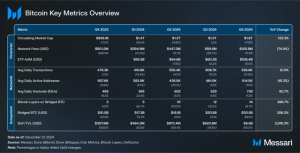Key Insights
- Over the last 18 months, Avalanche’s EVM-compatible C-Chain has supported the creation of a robust DeFi-focused dApp ecosystem by attracting a critical mass of users and developers with its low gas fees and transaction times.
- Despite the C-Chain’s high performance, it doesn’t provide a sustainable, long-term solution for scalability. Avalanche has started to address this by enabling projects to push out horizontally using subnets.
- Subnets are application-specific blockchain networks. They isolate performance and benefit from customizability, making them attractive to high-performance, blockspace-intensive applications (e.g., gaming/metaverse) and entities bound by complex rulesets (e.g., traditional financial institutions).
- The X-Chain is a nascent, underexplored design space, allowing users to create custom assets.
- The current narrative is around gaming subnets, with multiple blue-chip Web2 games slated to come on-chain and potentially bridge over their millions of users.
The Avalanche Network
Avalanche is a Proof-of-Stake (PoS) platform for creating digital assets, smart contracts, and application-specific blockchains. The network has a two-pronged strategy for optimizing performance: 1) novel consensus mechanisms that offer high throughput and speed with low fees, and 2) scaling horizontally by allowing projects to deploy their own subnetworks (subnets).
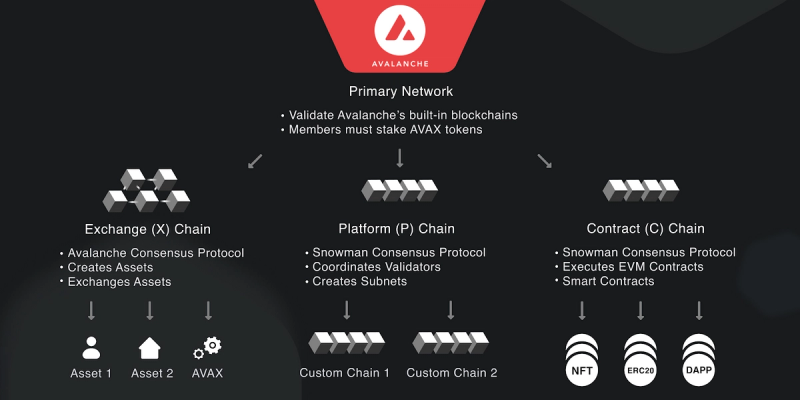
The umbrella network, the Primary Network, is composed of the C, P, and X chains. Today, the vast majority of Avalanche applications are deployed on the Contract Chain (C-Chain), Avalanche’s EVM-compatible smart contract platform. However, while Avalanche’s consensus brings speed and low fees, it doesn’t provide a long-term solution for scalability. To accomplish this, Avalanche enables projects to create custom blockchain networks (subnets) using the Platform Chain (P-Chain). Finally, the Exchange Chain (X-Chain) exists to create and move Avalanche-native digital smart assets. Like subnets, this design space is also fairly nascent and underexplored, but it has seen some unique projects (in use and under development) over the past year.
The Avalanche Ecosystem at a High Level
Two important metrics when assessing an ecosystem are developer and user activity.
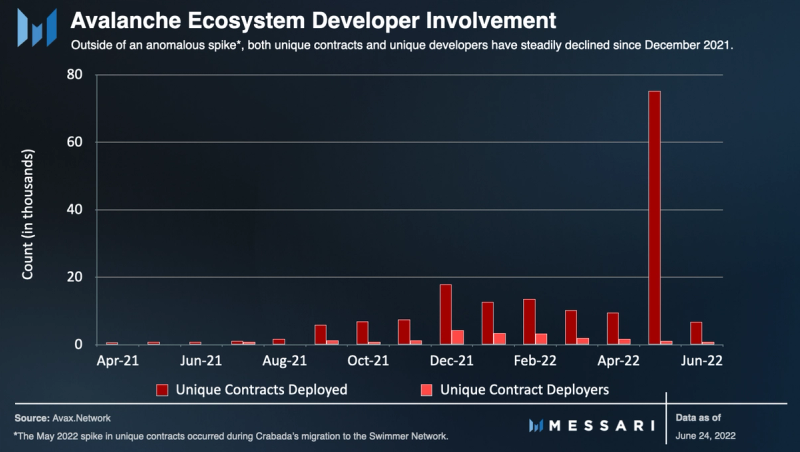
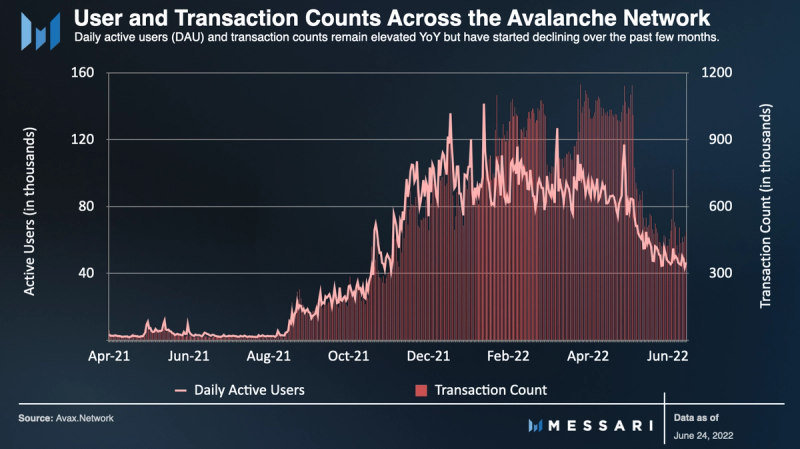
Unique contracts deployed, daily active users, and transaction count have declined alongside market conditions. Nonetheless, the numbers still sit much higher year-over-year.
Wallets, Exchanges, and Bridges
Up until recently, users could only have full access to the Avalanche network and its ecosystem by using an EVM-compatible plug-in wallet like Metamask in conjunction with the Avalanche Wallet (to access the X- and P-Chains). To bridge this gap and create a simple and comprehensive user experience, Ava Labs, lead developer of the Avalanche network, recently announced the beta release of Core. Core is a browser extension and mobile wallet that allows users to traverse the entire network and ecosystem (decentralized applications (dApps), subnets, and internal chains), as well as to natively bridge and swap assets.
The Avalanche-native Avalanche–Ethereum bridge is the largest Ethereum-connected bridge by total value locked (TVL). In addition to supporting ERC-20 token transfers to the C-Chain, the Avalanche Bridge plans to add support for the Bitcoin network (currently available through the Core Extension). For bridging assets from other chains (e.g., BNB, NEAR, Solana, etc.) the most popular bridges by TVL are Multichain, Stargate, and Synapse (in that order).
dApps and Subnets Overview
Over 200 projects call the Avalanche network home. These projects can be broadly categorized as either native or non-native. Thanks to the C-Chain’s EVM-compatibility and the robust bridging ecosystem around the Avalanche network, many live projects are non-native, meaning cross-chain (e.g., Aave, Curve, etc.). However, a subset of projects are native, meaning they only live on Avalanche, were started on Avalanche, or have the vast majority of their activity on Avalanche.
Another distinction between projects is where they’re deployed on the network. While the overwhelming majority of projects are still on the C-Chain, the first projects began to deploy their own subnets through the P-Chain starting in April. These custom, application-specific blockchain networks prevent projects from clogging up the network by splitting up traffic and isolating performance. In turn, the projects benefit from better performance and customizability in terms of fees, the validator set, the virtual machine, and more.
Avalanche has had its first two custom subnets go live along with the roll out of a number of testnet subnets. Looking forward, they are expected to play an increasingly important role in the ecosystem.
Ecosystem Funding
Just like projects, the groups funding the Avalanche ecosystem can be split into two categories: Avalanche-focused and general. Some Avalanche-focused capital allocators are the Avalanche Foundation, Ava Labs, AVentures DAO, Avatar Ventures, and projects such as Trader Joe and Avascan.
The most active member is the Avalanche Foundation, earmarking tens of millions of AVAX over the past year to fund the development and growth of the Avalanche ecosystem. In addition to individual financing rounds, its four wide-ranging initiatives to date have been Avalanche Rush, the Blizzard Fund, Multiverse, and the Culture Catalyst Initiative.
The other sources of funding for Avalanche-based projects have been the general public, angel investors, and investment firms.
Retail participants on Avalanche have had the opportunity to fund some noteworthy projects (e.g., Crabada and Platypus Finance) through launchpads such as Avalaunch and Rocket Joe and community-driven accelerator Colony Labs.
The most active “general” investment firms for early-stage Avalanche-native protocols, by deal count, have been Muhabbit Capital (MC) Ventures, GBV Capital, Shima Capital, Three Arrows Capital, and ZBS Capital.

Decentralized Finance (DeFi)
The properties of the C-Chain, especially with regards to performance and interoperability, primed it for a surge in DeFi activity. The two other catalysts were the introduction of Chainlink price feeds in June 2021 and the launch of liquidity mining incentive program Avalanche Rush thereafter. Despite the bulk of activity being less than a year old, the ecosystem has most of the primitives covered and is now in the process of moving into its experimentation phase.

Decentralized Exchanges (DEXs)
There are two widely-used sets of DEXs on Avalanche: general-purpose, constant product-based AMM-DEXs and StableSwap-based AMM-DEXs.
The two largest general-purpose DEXs (byvolume) are Avalanche-native Trader Joe and Pangolin. In addition to swaps and liquidity provision, both platforms offer yield farming, staking (for their native tokens, JOE and PNG), limit orders (via integrations), and leveraged trading. Pangolin offers leveraged trading through integrations with MarginSwap and WOWswap, while Trader Joe enables it through native lending protocol Banker Joe. Trader Joe also has its own launchpad, Rocket Joe, and NFT marketplace, Joepegs.
The two largest DEXs for trading similarly priced assets (i.e., stablecoins and wrapped tokens) are Platypus Finance and Curve. Avalanche-native Platypus differentiates itself from Curve by introducing the concept of asset liability management (ALM) and implementing single-variant (as opposed to invariant) curves. These two design decisions allow Platypus to offer liquidity providers (LPs) an open liquidity pool with single-sided provision and (under most circumstances) to offset the risk of impermanent loss.
Looking forward, Dexalot is another project that’s garnered interest. It is a decentralized, on-chain central limit order book (CLOB) that is already live on the C-Chain. However, the C-Chain’s properties (latency and gas fees) aren’t really suitable for a CLOB, and as a result, Dexalot is one of the first DeFi applications to transition into its own subnet. The Dexalot subnet is currently in its testnet and projected to launch in the next 1–2 months.
Lending
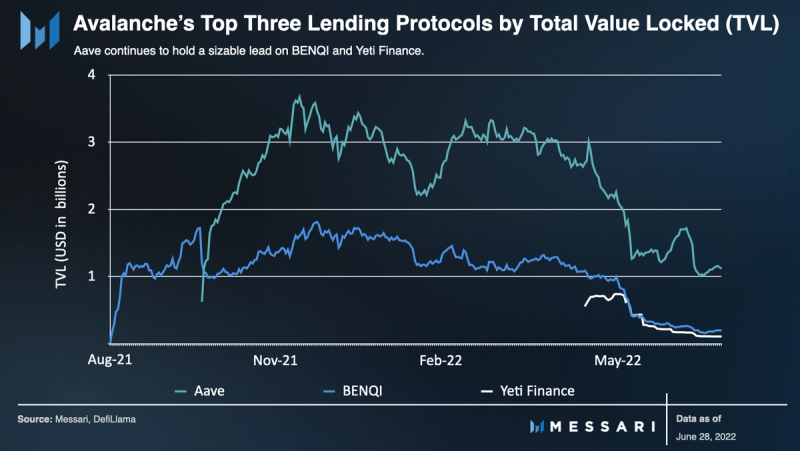
Avalanche’s largest application in terms of TVL is cross-chain liquidity protocol Aave. The next two largest lending protocols by TVL are Avalanche-native BENQI and Yeti Finance, respectively.
Aave and the BENQI Liquidity Market (BLM) are nearly identical in terms of their core functionality, allowing users to lend (earn interest) and borrow assets in an over-collateralized manner. However, BENQI differentiates itself through BENQI Liquid Staking (BLS), the first and (so far) only liquid staking protocol supporting AVAX.
BENQI Liquid Staked AVAX, sAVAX, allows holders to secure the Avalanche Primary Network and accrue staking rewards without rendering their AVAX illiquid. sAVAX can be used across C-Chain DeFi applications for additional yield and instant liquidity. As of this writing, sAVAX has a circulating supply of nearly 3 million, representing a little over 1% of all AVAX in circulation.
Looking ahead, BLS plans to play an integral role in the subnet ecosystem as well through the forthcoming launch of veQI, vote-escrowed QI (BENQI’s governance token). By vote-locking their QI, veQI holders will be able to direct staked AVAX to validate subnets of their choosing.
Yeti Finance fills an important niche in the Avalanche ecosystem by giving users the ability to borrow its overcollateralized stablecoin, YUSD, against their interest-bearing tokens (i.e., staked assets, LP tokens, or collateral deposited on other lending markets). Borrowers can collateralize a given, interest-free, YUSD loan with multiple assets while the Yeti Finance protocol auto-compounds their yield. Similar projects on Avalanche include Defrost Finance/H20, Abracadabra Money/MIM, Moremoney/MONEY, and Teddy Cash/TSD.
Derivatives
GMX was the first live perpetual futures market on Avalanche. While derivatives DEXs as a whole have struggled to take off, GMX has become a category leader thanks to its unique approach to zero-slippage swaps. GMX’s native index, GLP, is the floating basket of assets used for liquidity, and the price of assets within the pool is determined using market data from Chainlink. Since the beginning of the year, GMX has generated over $16 million in fees on Avalanche and distributed all of it back to GLP holders and GMX (token) stakers.
The Hubble Exchange, currently in testnet, will bring some competition to the perpetual futures landscape on Avalanche. Hubble differentiates itself by enabling multi-asset collateral and cross-margining. It also facilitates trades through a CurveCrypto invariant-based vAMM and unlocks composability with tokenized positions.
All of the live options protocols on Avalanche, as of this writing, are well-known cross-chain competitors. The two marketplace protocols are Opyn, which operates via order book and Dopex, which uses option selling vaults. There is also Arrow Markets, which is an Avalanche-native options protocol currently in testnet.
Arrow Markets will be the first options protocol on Avalanche to use an AMM. It will enable partial collateralization for options sellers and unlock the ability to combine options to create synthetic assets. While the pricing engine’s calculations will initially be done off-chain, the team hopes to eventually bring them on-chain — a strong use-case for a subnet given the computational load.
Like option marketplaces, the live structured product offerings on Avalanche are implementations of popular cross-chain protocols. The two largest, Ribbon Finance and Thetanuts Finance, focus on providing users vaults that execute a preset options-based yield strategy, abstracting away pricing and risk management.
Struct Finance recently raised seed capital to enable the creation of custom interest rate products. The Avalanche-based protocol plans to start with token splitting and then eventually allow users to create structured products that compose the fixed rate and yield tokens with options.
Aggregation Layer and VE-Wars
To understand the yield aggregator landscape on Avalanche it’s important to first understand the Joe Wars and Platypus Party. Trader Joe’s native token JOE and Platypus’ native token PTP can both be staked in exchange for veJOE and vePTP, respectively. These “vesting-escrowed” tokens can then boost liquidity mining APR on select farms.
Given the potential opportunity, a number of yield boosting aggregators have created offerings around the accumulation of ve-tokens. The two most popular yield aggregators (by TVL) are Avalanche-native Vector Finance and Yield Yak, respectively. While Yield Yak offers auto-compounded yield for 25 different protocols, Vector Finance is exclusively focused on maximizing farming yields for Trader Joe and Platypus Finance pools. Another similar project is Echidna Finance, which focuses exclusively on accumulating vePTP and providing boosted yield aggregation for Platypus pools. Farmer Frank and Convex-fork SteakHut Finance are also running the same playbook with veJOE and Trader Joe pools. Another notable player in the Joe Wars is cross-chain autocompounder Beefy Finance.
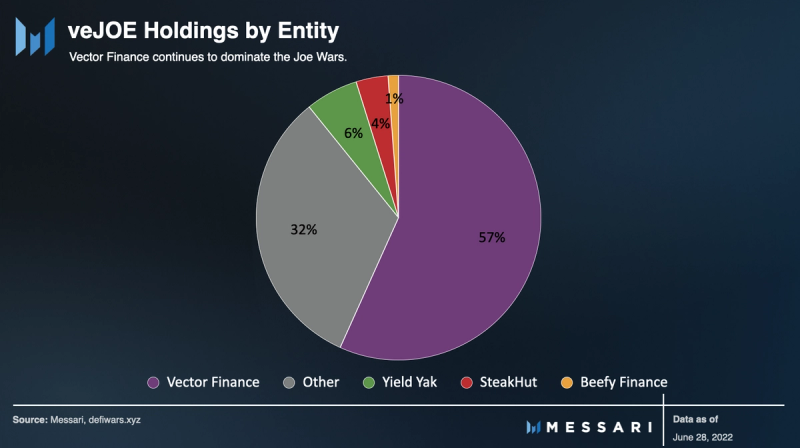

The enthusiasm around the accumulation of veJOE and vePTP is understandable. Given the centrality of Trader Joe and Platypus, once they enable voting gauges, projects will want to bribe large ve-tokenholders (e.g., Vector Finance and VTX tokenholders) for liquidity. Controlling these gauges could turn ve-holders into kingmakers in the Avalanche ecosystem.
Some of the most popular DEX aggregators on the Avalanche network include ParaSwap (integrated with Avalanche’s new Core wallet), 1inch, OpenOcean, and Matcha.
Institutional and Enterprise Adoption
Avalanche has been one of the few networks actually designed to support institutions. It allows institutions to tokenize assets and tailor blockchain networks as they see fit, especially with regards to regulatory compliance, data privacy, logic, and performance.
The single most salient development here came with Ava Labs’ announcement that it will collaborate with Aave, GoldenTree Asset Management, Wintermute, Jump Crypto, Valkyrie, and Securitize to build a permissioned subnet with native KYC functionality. This list of collaborators represents the upper crust of firms at the intersection of DeFi and traditional finance. Building this blockchain network will allow these dynamic and engaged regulated entities to actually use DeFi primitives, on-chain and at scale.
Avalanche has two other notable corporate partnerships with accounting firm Deloitte and publicly traded insurance company Lemonade. Ava Labs worked with Deloitte to create the Close As You Go platform to improve the process around Federal Emergency Management Agency (FEMA) reimbursements. The Lemonade Crypto Climate Coalition is building an application on Avalanche to provide weather insurance to subsistence farmers.
Notably, both firms cited Avalanche’s ecofriendliness as a reason behind choosing it to build out and house their projects.
Digital Assets
From the start, Ava Labs’ primary goal has been to “digitize all the world’s assets.” The Avalanche Primary Network’s X-Chain exists purely to facilitate the creation and movement of digital smart assets. The custom rulesets it enables can be designed to accommodate all types of assets and markets, pre-existing or otherwise.
Two unique, still very early stage digital assets deployed exclusively on Avalanche have been tokenized real estate by ReTok Finance and Initial Litigation Offerings (ILOs) by Ryval (founded by Roche Freedman LLP, Republic, and Ava Labs).
Gaming and NFTs
The case for performance isolation has been made very clear over the past few months with high-profile metaverse/gaming projects quickly cloggingupblockchains. The story arc behind Crabada, in particular, illustrates how Avalanche’s subnet technology could make it the go-to network for on-chain gaming.
Crabada is a crab-themed P2E game that launched exclusively on Avalanche’s C-Chain. Within three months, it quickly started racking up over 30% of the C-Chain’s daily transactions. This gave users across the C-Chain higher fees and latency. Serendipitously, for the Crabada community and all C-Chain users, subnets were ready for use (thanks to the launch of Subnet-EVM at the beginning of the year). In early May, Crabada bridged over to its own EVM-compatible subnet, the Swimmer Network.
As of now, DeFi Kingdoms is the other live subnet, expanding over to an EVM-compatible subnet directly from Harmony One with the launch of DeFi Kingdoms: Crystalvale.
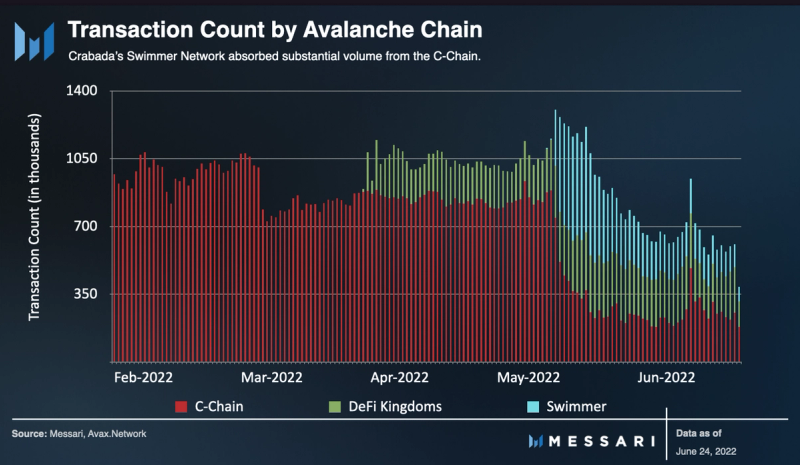
By successfully absorbing volume from the C-Chain, the Swimmer Network precipitated a meaningful decline in transaction fees. All-in-all, this illustrated the potential power of subnets and more directly was a win-win for Crabada users and the entire Avalanche ecosystem.
Looking ahead, the pipeline for subnets is filled with high-profile gaming projects — with Castle Crush and Highrise Worlds standing out in particular.
Castle Crush, currently in testnet, and community-owned metaverse Highrise World are well-established Web2 games. The games both have around 200,000 daily active users (DAU) and 1–2 million monthly active users (MAU). Castle Crush’s developer, Wildlife Studios, also happens to be the largest gaming company in Latin America with 1300 employees and 2 billion downloads across its 60+ titles.
Beyond bringing engaging, high-quality games to subnets, these crossovers could bridge millions of new users and dozens of experienced, high-caliber game developers on-chain. This is not just a huge development for subnets or Avalanche, but for the entire crypto ecosystem.
Other highly anticipated gaming subnets include first-person shooter Shrapnel, fantasy action RPG Heroes Chained, open-world RPG Ascenders, intergalactic metaverse Imperium Empires, and Pokemon-style MMORPG DeFimons.
Non-Gaming NFTs
While Avalanche’s robust gaming ecosystem has hoovered up a lot of attention, there is a separate, fledgling NFT scene as well.
Most NFT volume on Avalanche goes through Avalanche-native Kalao, Joepegs, and Campfire or cross-chain protocols NFTrade, Element Market, and tofuNFT.
Despite the market size, there have been some notable projects on Avalanche:
- Topps, one of the oldest collectible companies in the US, launched a 2021 MLB Series 2 Baseball NFT collection.
- One of renowned street artist Banksy’s most famous pieces, Love is in the Air, became a fractionalized NFT on Avalanche through Particle. Paris Hilton took part ownership of the project.
- Distinguished visual artist Jason M Peterson launched a 1-of-1 NFT of his Kanye West mural in Chicago’s West Loop neighborhood.
The $100 million Culture Catalyst Intiative should help drive NFT volume over coming quarters, starting with musician Grimes’ “intergalactic children’s metaverse book.”
Closing Thoughts
Although it might not seem like it, the Avalanche network is a mere 21 months old. Its ecosystem’s eye-popping growth over that time was the result of a shrewd and aggressive scaling strategy. Avalanche’s largest stakeholders successfully increased activity on the robust, EVM-compatible C-Chain by directing significant capital towards project and user incentives. Now that Avalanche has gained legitimacy and solid footing, the current ecosystem stakeholders must execute on its promising and differentiated scaling strategies.
Certain DeFi applications seem to have a strong natural fit with subnets. For example, derivatives, with their performance requirements, and institutions, with their needs around compliance, privacy, and control, seem like obvious targets.
However, the most promising category from both a user and project acquisition perspective is gaming. If Avalanche can crack some of the issues around scalability, such as seamless bridging between subnets and rapid validator bootstrapping for new networks, it could single-handedly bring a massive and entirely new class of users on-chain.


